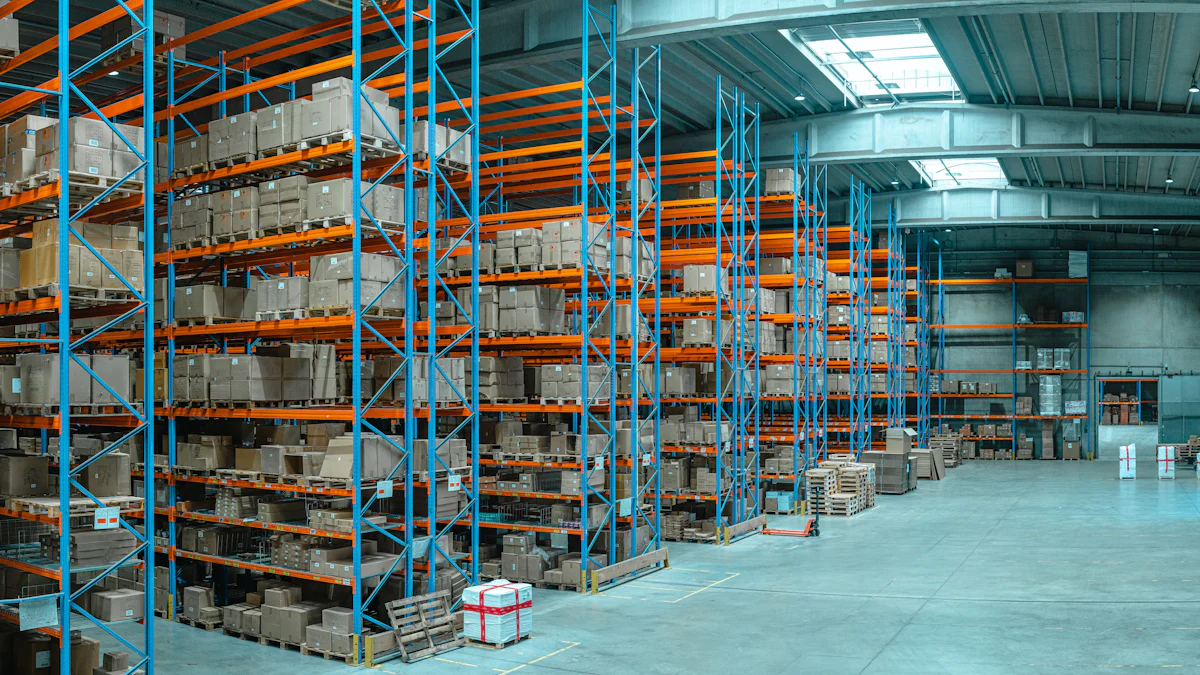Challenges Facing Ocean Shipping Amid Global Uncertainty

Ocean shipping serves as the backbone of international trade, facilitating the movement of goods across continents to meet global trade demands. However, 2025 presents unprecedented challenges for shipping companies. Geopolitical tensions, labor strikes, and inflation are reshaping freight operations. These disruptions demand innovative strategies to ensure stability and efficiency in an increasingly volatile environment.
Key Takeaways
Political conflicts and trade fights are changing ocean shipping. Shipping companies must adjust to new taxes and routes to stay ahead.
Rising prices are making shipping more expensive to run. Companies should find new ways to save money and stay successful.
Fewer workers are causing delays and higher costs. Shipping companies need better pay and training programs to keep workers.
Geopolitical and Economic Challenges in Ocean Shipping

Trade Wars and Tariffs Impacting Ocean Freight
Trade wars and tariffs have significantly reshaped the ocean freight market. The National Retail Federation reported that the steady growth in U.S. container imports from 2009 to 2018 was disrupted in 2019. Businesses frontloaded shipments in anticipation of tariff hikes, leading to reduced container volumes the following year. Tariffs on high-value goods have decreased demand for containerized cargo, particularly on major routes like trans-Pacific and Asia-Europe. Similarly, U.S. tariffs on foreign steel have reduced bulk carrier demand, while automotive tariffs have disrupted RoRo shipping, causing a decline in transatlantic vehicle traffic. These shifts highlight the challenges shipping companies face in adapting to fluctuating trade policies.
Additionally, U.S. tariffs on Chinese goods have prompted manufacturers to relocate to Southeast Asia, increasing demand for intra-Asian shipping routes. This geopolitical context underscores the need for robust geopolitical risk management strategies to navigate these disruptions effectively.
Inflation and Economic Pressures on 2025 Ocean Freight
Inflation continues to exert pressure on the shipping sector. Rising fuel and raw material costs have driven up operational expenses, directly impacting freight rates. The 2025 ocean freight market is expected to remain inflationary, with higher demand pushing rates upward. However, the interplay between inflation and tariffs creates volatility. Businesses often frontload shipments before tariff implementation, temporarily elevating rates. Once tariffs take effect, demand may decline, leading to rate adjustments.
Economic pressures also stem from fluctuating fuel prices and new regulations requiring costly vessel modifications. These factors add complexity to the ocean freight market, compelling shipping alliances to adopt innovative strategies to mitigate risks and maintain competitiveness.
Regional Conflicts and Disruptions in Global Shipping Routes
Regional conflicts pose significant risks to global shipping routes. Tensions in the South China Sea force vessels to reroute, increasing transit times and costs. Similarly, the ongoing war in Ukraine disrupts Black Sea shipping, affecting grain exports and necessitating costlier overland alternatives. In the Red Sea, Houthi attacks on commercial vessels elevate security expenses and delay deliveries.
The Strait of Hormuz remains a critical chokepoint, with Iran-U.S. tensions threatening oil trade and causing price volatility. Speculation about U.S. involvement in the Panama Canal adds further uncertainty. These geopolitical challenges demand proactive strategies from shipping companies to ensure route reliability and minimize disruptions.
Environmental and Regulatory Challenges in 2025 Ocean Freight

Decarbonization and Compliance with IMO 2025 Regulations
The International Maritime Organization (IMO) 2025 regulations present significant challenges for the shipping sector. These rules mandate a substantial reduction in greenhouse gas emissions, compelling shipping companies to adopt cleaner technologies and fuels. Meeting these requirements involves several hurdles:
Stricter environmental regulations demand immediate action to reduce emissions.
Rising costs associated with alternative fuels and retrofitting vessels strain operational budgets.
The shift toward digitalization requires skilled labor and advanced systems, adding complexity to compliance efforts.
Shipping companies must balance these demands while maintaining operational efficiency. Investments in energy-efficient vessels, alternative fuels like LNG, and digital tools for emissions tracking are becoming essential. These measures not only ensure compliance but also enhance the safety of ships by improving operational performance.
Stricter Emission Standards and Their Impact on Ocean Shipping
Stricter emission standards are reshaping the ocean shipping landscape. Companies are adopting innovative strategies to reduce their carbon footprint. Fuel-saving ship designs, such as ducktails and advanced hull coatings, are gaining traction. Alternative fuels, including biofuels and LNG, are being integrated into fleets. Digital technologies like IoT and big data analytics are optimizing routes and tracking fuel consumption.
Operational practices, such as slow steaming and proactive hull maintenance, further contribute to emission reductions. These advancements, while promising, come with financial and logistical risks. Shipping companies must carefully evaluate the cost-benefit ratio of these upgrades to remain competitive in the evolving freight market.
Stakeholder Demands for Sustainable Ocean Freight Practices
Stakeholders across the shipping sector are advocating for sustainable practices. Their demands include clear guidelines, international collaboration, and financial incentives.
Demand Type | Description |
|---|---|
Guidelines | Universally accepted standards ensure a level playing field for all players. |
Collaboration | Governments, regulators, and industry leaders must work together to establish green shipping norms. |
Financial Incentives | Subsidies and tax breaks encourage investments in sustainable technologies. |
These demands highlight the growing emphasis on sustainability in ocean freight. Addressing these expectations requires a proactive approach, integrating innovative solutions to meet environmental goals while ensuring the safety of ships and the efficiency of operations.
Operational Challenges in Ocean Shipping
Labor Shortages and Workforce Retention in 2025
Labor shortages continue to challenge the shipping sector, creating ripple effects across the ocean freight market. Insufficient workforce availability exacerbates port congestion, leading to operational delays and increased shipping costs. Aging labor pools and post-pandemic shifts have further strained workforce capacity, making it difficult for shipping companies to meet growing demand. Unresolved tensions between labor unions also pose risks, with potential strikes threatening to disrupt operations and worsen supply chain hurdles.
To address workforce retention, shipping companies are implementing strategies to attract and retain talent. Competitive compensation packages, career growth opportunities, and work-life balance initiatives are becoming standard practices. For example, companies are offering flexible working arrangements and professional development programs to foster a positive work environment. These measures aim to stabilize the workforce and mitigate risks associated with labor shortages.
Port Congestion and Infrastructure Limitations
Port congestion remains a critical issue in the 2025 ocean freight market. Increased trade volumes often overwhelm port facilities, while insufficient infrastructure hampers efficient cargo handling. Labor shortages and equipment deficits, such as a lack of chassis for container transport, further compound the problem. Weather disruptions and regulatory delays also contribute to shipping delays, creating bottlenecks that ripple through global supply chains.
Shipping companies are investing in infrastructure upgrades and digital solutions to alleviate congestion. Advanced technologies like IoT and AI are optimizing port operations, enabling real-time tracking and efficient cargo movement. These innovations aim to reduce operating costs and enhance the safety of shipping operations.
Overcapacity and Freight Pricing Dynamics
Overcapacity in the shipping industry disrupts supply and demand dynamics, significantly influencing freight pricing. A surplus of vessels often suppresses freight rates, creating financial challenges for shipping companies. Declining scrapping activity has resulted in an aging fleet, limiting the adoption of newer, more efficient ships. Uneven global demand and geopolitical uncertainties further complicate the outlook for the ocean freight market.
To address these challenges, shipping companies are adopting strategies to balance supply and demand. Fleet optimization, route adjustments, and collaborative shipping alliances are helping stabilize freight rates. These measures aim to ensure profitability while maintaining service reliability in an unpredictable market.
Technological Challenges and Opportunities in Ocean Freight
Cybersecurity Risks in Digitalized Ocean Shipping
The increasing reliance on digital systems in ocean shipping has introduced significant cybersecurity risks. Threats such as ransomware attacks can cripple operations by encrypting critical systems and demanding ransom payments. Phishing attacks target crew members and shore-based personnel, leading to unauthorized access to sensitive data. GPS spoofing and jamming disrupt navigation, potentially causing collisions or delays. Data breaches expose cargo manifests and operational details, resulting in theft or fraud. Additionally, vulnerabilities in the interconnected supply chain can create cascading effects across the ocean freight market.
Several factors exacerbate these risks. Many shipping companies lack visibility into operational technology (OT) networks, leaving systems exposed. Unsecured wireless networks and 24/7 remote access granted to third-party vendors further increase vulnerabilities. To mitigate these challenges, companies are conducting regular risk assessments, implementing cybersecurity training programs, and developing incident response plans to minimize disruptions.
Adoption of AI, IoT, and Automation in 2025 Ocean Freight
The adoption of AI, IoT, and automation is transforming the 2025 ocean freight landscape. These technologies enhance operational efficiency, reduce costs, and improve customer satisfaction. For instance, IoT-enabled vehicle tracking optimizes routing and reduces operating costs. Predictive maintenance lowers maintenance expenses by up to 40%, while real-time updates improve delivery reliability.
Benefit | Description |
|---|---|
Operational Efficiency | Real-time data helps streamline logistics processes, lower operational costs, and improve customer service. |
Cost Reduction | Predictive maintenance and optimized routing significantly lower operational expenses. |
Customer Satisfaction | Real-time updates and precise delivery tracking enhance reliability and trust among customers. |
Despite these benefits, companies face challenges such as data privacy concerns, interoperability issues, and the need for scalable solutions. Addressing these requires robust strategies to secure data and integrate diverse systems effectively.
Balancing Costs and Benefits of Technological Upgrades
Balancing the costs and benefits of technological upgrades remains a critical challenge for the ocean freight market. Technologies like blockchain enhance data accuracy and reduce fraud risk, while autonomous vessels lower labor costs and improve safety. However, implementing these innovations requires significant investment, which can strain operating costs.
Shipping companies must adopt strategic approaches to manage these expenses. Enhanced visibility through digital tools empowers informed decision-making, allowing businesses to evaluate the necessity of specific technologies. Collaborative strategies, such as multi-level approval processes, ensure accountability and optimize resource allocation. By carefully weighing costs against long-term benefits, companies can maintain competitiveness while addressing supply and demand dynamics.
JUSDA’s Role in Addressing Ocean Shipping Challenges
Leveraging JUSDA’s Global Network for Efficient Ocean Freight
JUSDA’s global network addresses the challenges of ocean shipping by offering comprehensive supply chain solutions. Its holistic approach integrates VMI, cross-border logistics, warehousing, and distribution, ensuring seamless operations. This breadth of services provides unmatched flexibility and responsiveness, enabling shipping companies to adapt to supply chain disruptions effectively.
The network’s technological integration enhances visibility and control, improving service reliability. For instance, the JusLink Smart Supply Chain Management Platform offers end-to-end visibility, utilizing advanced tools like RFID and WMS to optimize operations. In North America, JUSDA focuses on cross-border VMI services and consolidation centers, improving response times. In Vietnam, the integration of air and sea transportation facilitates logistics for over 20,000 SKUs, while in India, a robust warehousing and distribution system supports local industries.
Feature | Description |
|---|---|
Comprehensive Service Offerings | Covers all supply chain aspects, ensuring seamless integration and operational efficiency. |
Technological Integration | Utilizes advanced technologies for visibility and control, enhancing service reliability. |
Customer-Centric Approach | Tailors solutions to specific industry needs, driving high customer satisfaction. |
JUSDA’s Warehouse Solutions for Optimized Supply Chains
JUSDA’s warehousing solutions play a pivotal role in mitigating supply chain disruptions. With over 2.5 million square meters of warehouse space globally, JUSDA provides tailored storage options, including bonded warehouses, distribution centers, and cleanroom facilities. These solutions cater to diverse industries, ensuring efficient inventory management and logistics planning.
The use of advanced systems like eVMI and JusLink enables real-time inventory tracking, enhancing transparency and control. Value-added services such as picking, packing, and labeling further streamline operations, reducing operating costs for shipping companies. By integrating these strategies, JUSDA ensures optimized supply chains that address the complexities of modern freight logistics.
JusLink Intelligent Supply Chain for Real-Time Collaboration
The JusLink Intelligent Supply Chain platform revolutionizes ocean shipping by providing real-time collaboration and visibility. Its features include real-time tracking, predictive analytics, and IoT integration, which enhance operational efficiency and reduce inefficiencies.
Benefit | Description |
|---|---|
Enhanced Visibility | Real-time tracking provides constant shipment visibility. |
Efficiency | Streamlined operations foster collaboration, reducing inefficiencies. |
Proactive Issue Resolution | Predictive analytics anticipate rate changes and identify cost-saving opportunities. |
JusLink’s predictive analytics anticipate market trends, enabling proactive decision-making. By fostering collaboration across the supply chain, the platform minimizes risks and enhances efficiency. These capabilities make JusLink an indispensable tool for shipping alliances seeking to navigate the complexities of ocean freight.

JUSDA Solutions
To provide you with professional solutions and quotations.
Ocean shipping in 2025 faces numerous challenges, including labor shortages, geopolitical tensions, and stricter environmental regulations. Proactive planning enables shipping companies to mitigate risks and adapt to evolving market conditions. Innovations like robotics, predictive analytics, and green shipping solutions are transforming freight operations. JUSDA remains committed to delivering efficient, sustainable logistics solutions for global trade.
See Also
Addressing Global Supply Chain Growth Challenges Effectively
Achieving Success Through Enhanced Supply Chain Visibility Online
Understanding Current Trends in Logistics Risk Management
Exploring Innovations in Sea Freight Logistics for 2024
Get Prepared: Discovering New Transport Technologies for Supply Chains
